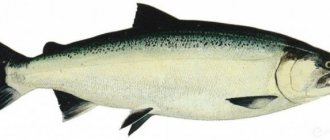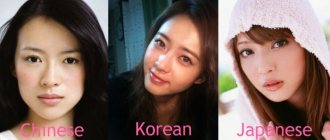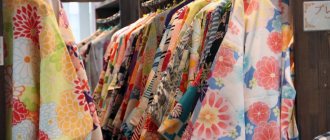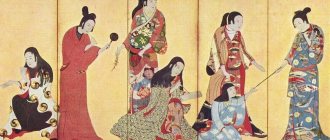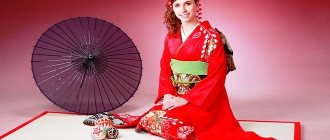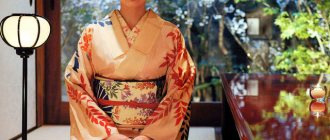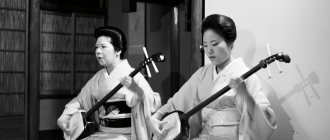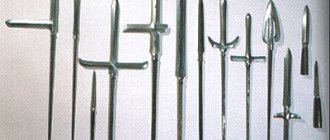What is yukata? What and when to wear it with? And where to buy?
The Japanese began wearing yukata in the Middle Ages. These were clothes you could relax in after taking a bath. Later, yukata became summer clothing for both indoors and outdoors.
1. What is yukata?
2. How does a yukata differ from a kimono?
3. How much does a yukata cost in Japan?
4. Where to buy a yukata?
5. Yukata accessories?
Difference between kimono and yukata
Each of us knows that all nations have their own festive and everyday clothes. It is distinguished by its history, design and simply convenience for people. So the Japanese have two somewhat similar costumes. At first glance they seem the same. But is this really so?
Traditional Japanese clothing dates back to the 5th-7th centuries and becomes an integral part of the life of the Japanese with a very reverent attitude towards it. For example, three categories of clothing were introduced - ceremonial, court and work. Color and even length showed status in society.
The kimono appears at the dawn of Japanese fashion. During the Edo period (1603–1867), sleeves grew in length, becoming especially elongated for unmarried women. The obi (belt) became wider, and different ways of tying the belt appeared. Since that time, the shape of the kimono has remained almost unchanged. Kimonos are also the work clothes of geishas. The Japanese holiday “Shichi-Go-San” (a traditional holiday-festival in Japan) is associated with kimono.
In modern Japanese, there are three words for Japanese traditional clothing, the first of which is “kimono”. In Japan in the mid-19th century, this word meant any clothing. Back in the 16th century, Portuguese Jesuit missionaries reported in reports to Europe that the Japanese called clothing the word “kimono.” Although before modern Japan, “kimono” was an analogue of the universal concept of “clothing,” in Europe and America it became associated specifically with Japanese attire. Now this is the national Japanese costume, which is worn only on holidays.
Speaking about yukata, it should be noted that initially it was a robe for the bathroom. Yukata is a light robe wrapped around the body and secured with a belt in the form of a strip of fabric. The suit is very easy to sew. Yukata is not limited to just being worn after a bath, it is also worn in the summer. Japanese people in these clothes can often be seen during festivals or in cities where hot springs flow. National attire is also offered to guests of traditional Japanese hotels.
Main differences The kimono itself is a suit made of thick fabric, in contrast to the yukata, created for the summer. Yukata is very easy to wear, which is another reason why the Japanese wear it in the summer and in hot weather. There is a noticeable difference in price and materials - a kimono is traditionally made of silk or satin and can cost tens of thousands of dollars or more. Material and purpose are not the only ways the two national costumes differ.
There are also some features: The kimono has two collars - one for the robe itself, and the second for the light cotton garment worn underneath, called juban.
An obligatory part of a formal costume is wooden sandals with fabric socks. With the Japanese yukata, the feet can remain bare.
There are variations of obi belts for kimonos, varying in width, softness of material and tying methods. The “bathrobe” is tied only at the front.
Ceremonial clothing is more difficult to care for - to wash it, it is ripped out and then sewn again. A real kimono consists of dozens of elements, and putting it on by yourself is not easy.
Nowadays, the Japanese wear regular clothes, and wear kimonos and yukatas only for holidays or some other events. A lot of things change in fashion, and so do traditional outfits. Designers change them and make life more convenient for our rhythm or simply try to create a work of art.
This is a useful read:
- Team LAB Museum
- Japanese DJ Sumiko Iwamuro
- Castles of Japan
Full set
Should I wear underwear under a kimono? Now this is exactly what they do, although in the traditional version nothing like this was envisaged. Until now, many in Japan believe that when the outline of underwear is visible under thin fabric, it is ugly. But what you definitely need are cloth, leather or straw zori sandals and high (ankle-length) tabi socks with a special compartment for the big toe. And don’t forget about kanzashi - decorations for the hairstyle worn under the kimono! They can be silk flowers, wooden combs, jade hairpins...
What is yukata?
Yukata is a type of summer kimono. It is simpler in style than a classic kimono.
The Japanese began wearing yukata in the Middle Ages. These were clothes you could relax in after taking a bath. Later, yukata became summer clothing for both indoors and outdoors.
Nowadays, the Japanese wear yukata when they go out to summer festivals, watch fireworks, or visit temples. Especially in historical cities like Kyoto, Kamakura, Kanazawa, Kurashiki or Tokyo, it is not uncommon to see both Japanese and foreigners walking around in yukata.
Outside of Japan, you may also have the opportunity to wear a yukata. It could be an anime festival or a cosplay show, a house party or a cultural exchange. You can also wear a yukata at home!
Compared to other types of kimono, yukata is very easy to wear. We can easily put it on ourselves. This does not require the help of a professional, as with other kimonos. In addition, yukata are very affordable.
Overall, if you like Japanese traditional clothing and would like to get to know it better, yukata is the best place to start!
What is the difference between a yukata and a kimono?
We said earlier that “yukata is a type of summer kimono.” Does this mean that yukata is a kimono? This is not entirely true. Let's understand the terminology.
Kimono (着物) is any Japanese clothing. The word itself consists of two characters: 着 - to wear and 物 - thing. Those. A kimono is a thing that is worn, or clothing. Before the arrival of Europeans and Western-style clothing in the country, the word “kimono” was used to describe any clothing. Afterwards, this word began to be used only in relation to Japanese-style clothing. Thus, clothing in Japan began to be divided into Western and traditional Japanese. The latter began to be called wafuku (和服 - literally Japanese clothing, as opposed to 洋服 - Western clothing). And although among the Japanese, kimono and wafuku mean the same thing, in the Russian-speaking tradition, the word “kimono” refers specifically to formal types of Japanese clothing, and the word “yukata”, respectively, refers to its less formal forms. We will also use this word in the Russian interpretation: “kimono” as formal traditional Japanese clothing (or wafuku), and “yukata” as summer traditional Japanese clothing.
Got it? Now let's see what the difference is between a kimono and a yukata.
- Season
Yukata is worn only in summer. The only exception is if you wear a yukata at home, and use it as a nightgown (that's right, yukata was used as sleepwear before the advent of pajamas!). For example, in most Japanese-style hotels and hot springs, guests are given a yukata so that they can change into clean clothes after a bath, dress up and enjoy their vacation without worrying about what to wear. Except in this case, passers-by in yukata can only be seen in summer.
Therefore, kimonos are worn less often in summer, but they can still be worn at any time of the year. For a kimono, the next point is much more important.
- Occasions and occasions for yukata and kimono
Yukata is clothing for entertainment. You can wear a yukata to a festival or a date, while traveling to historical sites in Japan and visiting a temple.
Kimonos are worn only on special or official occasions: weddings, official visits or receptions, various ceremonies (graduation, anniversary ceremony, etc.)
- Material
Since yukata is intended for summer, it is made from lighter material. Usually it is cotton. Recently they are also made from polyester. This material is highly breathable and dries quickly, so a polyester yukata will be comfortable in summer.
Kimono materials include silk, cotton and even wool. The kimono fabric is denser and practically does not allow air to pass through.
- Design
Since yukata are meant for entertaining and going out, they come in almost all colors and shapes. These can be calm colors with traditional patterns, or more colorful options with flowers, or even with characters. The patterns usually cover the entire yukata.
Kimonos can also combine different colors, but most often they will be deeper tones and traditional patterns. The ornament is only on the bottom of the robe and sometimes on the sleeves. The most striking type of kimono is the furisode (振袖 - long-sleeved kimono), which young girls wear for their coming of age ceremony at the age of 20.
- Underwear kimono
A thin white robe is most often worn under the yukata. It absorbs sweat and simplifies the mid-wash process. A yukata should not be hot, so there is no point in wearing a lot of things underneath.
As for the kimono, you will first have to wear several layers underneath: a robe over your naked body, an underskirt and a long robe, at a minimum.
feel the difference
A kimono is a straight, long robe without fasteners, wrapped to the right and tied with an obi belt. The Japanese obi belt is not at all the same as a sash or trouser belt. This is not just a piece of clothing, but a health-improving device, something like a bandage for the abdomen and lower back: it prevents the former from sagging, and the latter from getting too tired. The design has been perfected over thousands of years, so everything is thought out! A women's belt up to 35 cm wide in bright colors is tied with a wide bow on the back along the waist line, while a men's belt is narrow (up to 10 cm), modest in color and is located at the hip line.
As for the kimono itself, it consists of two skirts, which are sewn together in the middle of the back and on the sides, with large armholes. The sleeves of a woman's kimono are very wide - up to 150 cm, but the holes for the palms and wrists are not made the entire width, but only in the upper part measuring 30 cm. The remaining part of the sleeve is sewn from the bottom and along the front edge, forming a bag. It is not stitched from the inside. But the sleeves of a men's kimono (up to 40 cm wide) are stitched along the entire width of the armhole.
Yukata is a lightweight type of kimono, which, in fact, we are accustomed to. This light cotton robe is worn by Japanese women in the summer while relaxing, at home and on the street.
It is included in the set of bed linen provided by hotels. And when visiting the hot springs, you receive a yukata along with a towel “from the establishment.” As home clothing, there is nothing more comfortable and physiological than a yukata: it is not for nothing that robes tailored in its image and likeness are so popular in Russia.
Where can I try on a yukata?
- One of the best ways to try on a yukata is at a ryokan or onsen. Most ryokans provide one for each guest to wear both inside the hotel and outside.
- In Japanese hotel rooms, guests are offered to change into yukata (a version of pajamas).
- Another option is kimono rental shops. Such stores are especially common in Kyoto.
- You can buy yukata in specialized stores or shopping centers. Near most attractions you can find souvenir shops selling cheap versions of yukata. For example, in the Asakusa area on Nakamise shopping street.
Difference between kimono and yukata
Yukata is an unlined cotton kimono worn in the summer (on the left in the photo). The main difference is in the fabric: kimono is made of silk, and yukata is made of cotton, they are similar in style, but yukata does not have long sleeves and complex patterns.
Yukata is worn in hot weather, during summer holidays, and is rarely used as home wear. Instead of two layers, the clothing is made in a single layer and is shorter in comparison to a kimono.
There are several negative features of wearing a kimono:
- a kimono is very difficult to put on by yourself, without outside help; the whole process takes about half an hour;
- you cannot sew it yourself;
- inheritance traditions have become difficult to maintain due to the penchant of young people for comfortable European clothing.
Thus, nowadays the kimono is more of a historical and festive character than an everyday one.
